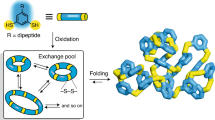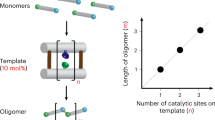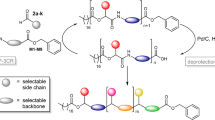Abstract
Information storage and processing is carried out at the level of individual macromolecules in biological systems, but there is no reason, in principle, why synthetic copolymers should not be used for the same purpose. Previous work has suggested that monomer sequence information in chain-folding synthetic copolyimides can be recognized by tweezer-type molecules binding to adjacent triplet sequences, and we show here that different tweezer molecules can show different sequence selectivities. This work, based on 1H NMR spectroscopy in solution and on single-crystal X-ray analysis of tweezer–oligomer complexes in the solid state, provides the first clear-cut demonstration of polyimide chain-folding and adjacent-tweezer binding. It also reveals a new and entirely unexpected mechanism for sequence recognition, which, by analogy with a related process in biomolecular information processing, may be termed ‘frameshift-reading’. The ability of one particular tweezer molecule to detect, with exceptionally high sensitivity, long-range sequence information in chain-folding aromatic copolyimides is readily explained by this novel process.
This is a preview of subscription content, access via your institution
Access options
Subscribe to this journal
Receive 12 print issues and online access
$259.00 per year
only $21.58 per issue
Buy this article
- Purchase on Springer Link
- Instant access to full article PDF
Prices may be subject to local taxes which are calculated during checkout







Similar content being viewed by others
References
Watson, J. D. & Crick, F. H. C. A structure for deoxyribose nucleic acid. Nature 171, 737–738 (1953).
Wilkins, M. H. F., Stokes, A. R. & Wilson, H. R. Molecular structure of deoxypentose nucleic acids. Nature 171, 738–740 (1953).
Franklin R. E. & Gosling, R. G. Molecular configuration in sodium thymonucleate. Nature 171, 740–741 (1953).
Crick, F. H. C. On protein synthesis. Symp. Soc. Exptl Biol. 12, 138–163 (1958).
Nirenberg, M. Historical review: deciphering the genetic code—a personal account. Trends Biochem. Sci. 29, 46–54 (2004).
Dawkins, C. R. The Blind Watchmaker (Longmans, 1986).
Lodish, H. et al. Molecular Cell Biology 6th edn (Freeman, 2007).
Burd, C. & Weck, M. Self-sorting in polymers. Macromolecules 38, 7225–7230 (2005).
Weck, M. Side-chain functionalized supramolecular polymers. Polym. Int. 56, 453–460 (2007).
Harmata, M. Chiral molecular tweezers. Acc. Chem. Res. 37, 862–873 (2004).
Klärner, F.-G. & Kahlert, B. Molecular tweezers and clips as synthetic receptors. Molecular recognition and dynamics in receptor−substrate complexes. Acc. Chem. Res. 36, 919–932 (2003).
Chen, C. W. & Whitlock, H. W. Molecular tweezers—a simple model of bifunctional intercalation. J. Am. Chem. Soc. 100, 4921–4922 (1978).
Zimmerman, S. C. & VanZyl, C. M. Rigid molecular tweezers—synthesis, characterization and complexation chemistry of a diacridine. J. Am. Chem. Soc. 109, 7894–7896 (1987).
Kurebayashi, H., Haino, T., Usui, S. & Fukazawa, Y. Structure of supramolecular complex of flexible molecular tweezers and planar guest in solution. Tetrahedron 57, 8667–8674 (2001).
Balzani, V. et al. Host−guest complexes between an aromatic molecular tweezer and symmetric and unsymmetric dendrimers with a 4,4′-bipyridinium core. J. Am. Chem. Soc. 128, 637–648 (2006).
Klärner, F.-G. et al. Molecular tweezer and clip in aqueous solution: unexpected self-assembly, powerful host−guest complex formation, quantum chemical H-1 NMR shift calculation. J. Am. Chem. Soc. 128, 4831–4841 (2006).
Goshe, A. J., Steele, I. M., Ceccarelli, C., Rheingold, A. L. & Bosnich, B. Supramolecular recognition: on the kinetic lability of thermodynamically stable host−guest association complexes. Proc. Natl Acad. Sci. USA 99, 4823–4829 (2002).
Peng, X.-X., Lu, H.-Y., Han, T. & Chen, C.-F. Synthesis of a novel triptycene-based molecular tweezer and its complexation with paraquat derivatives. Org. Lett. 9, 895–898 (2007).
Colquhoun, H. M. & Zhu, Z. Recognition of polyimide sequence information by a molecular tweezer. Angew. Chem. Int. Ed. 43, 5040–5045 (2004).
Colquhoun, H. M., Zhu, Z., Cardin, C. J. & Gan, Y. Principles of sequence-recognition in aromatic polyimides. Chem. Commun. 2650–2652 (2004).
Colquhoun, H. M., Zhu, Z., Cardin, C. J., Gan Y. & Drew, M. G. B. Sterically controlled recognition of macromolecular sequence information by molecular tweezers. J. Am. Chem. Soc. 129, 16163–16174 (2007).
Colquhoun, H. M., Zhu, Z., Cardin, C. J., Drew, M. G. B. & Gan, Y. Recognition of sequence-information in synthetic copolymer chains by a conformationally-constrained tweezer molecule. Faraday Discuss. 143, 205–220 (2009).
Hamilton, D. G., Sanders, J. K. M., Davies, J. E., Clegg, W. & Teat, S. J. Neutral [2]catenanes from oxidative coupling of π-stacked components. Chem. Commun. 897–898 (1997).
Hamilton, D. G., Lynch, D. E., Byriel, K. A., Kennard C. H. L. & Sanders, J. K. M. N-alkylation of pyromellitic diimide: solid-state structure of the 1:1 N,N′-diethylpyromellitic diimide 2,6-dimethoxynaphthalene cocrystal. Aust. J. Chem. 51, 441–444 (1998).
Hamilton, D. G., Davies, J. E., Prodi, L. & Sanders, J. K. M. Synthesis, structure and photophysics of neutral π-associated [2]catenanes. Chem. Eur. J. 4, 608–620 (1998).
Hamilton, D. G., Feeder, N., Teat, S. J. & Sanders, J. K. M. Reversible synthesis of π-associated [2]catenanes by ring-closing metathesis: towards dynamic combinatorial libraries of catenanes. New J. Chem. 22, 1019–1021 (1998).
Kaiser, G. et al. Lithium-templated synthesis of a donor−acceptor pseudorotaxane and catenane. Angew. Chem. Int. Ed. 43, 1959–1962 (2004).
Vignon, S. A. et al. Switchable neutral bistable rotaxanes. J. Am. Chem. Soc. 126, 9884–9885 (2004).
Iijima, T. et al. Controllable donor−acceptor neutral [2]rotaxanes. Chem. Eur. J. 10, 6375–6392 (2004).
Pascu, S. I. et al. Cation-reinforced donor−acceptor pseudorotaxanes. New J. Chem. 80–89 (2005).
Hansen, J. G., Bang, K. S., Thorup N. & Becher, J. Donor−acceptor macrocycles incorporating tetrathiafulvalene and pyromellitic diimide: syntheses and crystal structures. Eur. J. Org. Chem. 2135–2144 (2000).
Colquhoun, H. M., Stoddart, J. F., Williams, D. J., Wolstenholme, J. B. & Zarzycki, R. Second-sphere coordination of cationic platinum complexes by crown ethers—the X-ray crystal-structure of [Pt(bpy)(NH3)2.dibenzo[30]crown-10]2+[PF6]−2.xH2O (x=0.6). Angew. Chem. Int. Ed. Engl. 20, 1051–1053 (1981).
Colquhoun, H. M. et al. Complex-formation between dibenzo-3n-crown-n ethers and the diquat dication. J. Chem. Soc., Chem. Commun. (pre-1996) 1140–1142 (1983).
Allwood, B. L., Spencer, N., Shahriari-Zavareh, H., Stoddart, J. F. & Williams, D. J. Complexation of diquat by a bisparaphenylene-34-crown-10 derivative. J. Chem. Soc., Chem. Commun. (pre-1996) 1061–1064 (1987).
Ashton, P. R., Slawin, A. M. Z., Spencer, N., Stoddart, J. F. & Williams, D. J. Complex formation between bisparaphenylene-(3n+4)-crown-n ethers and the paraquat and diquat dications. J. Chem. Soc., Chem. Commun. (pre-1996) 1066–1069 (1987).
Krebs, F. C. & Jørgensen, M. A new versatile receptor platform. J. Org. Chem. 66, 6169–6173 (2001).
Koshkakaryan, G. et al. Alternative donor−acceptor stacks from crown ethers and naphthalene diimide derivatives: rapid, selective formation from solution and solid state grinding. J. Am. Chem. Soc. 131, 2078–2079 (2009).
Peinador, C., Blanco V. & Quintela, J. A new doubly interlocked [2]catenane. J. Am. Chem. Soc. 131, 920–921 (2009).
Ulrich, S. & Lehn, J.-M. Adaptation and optical signal generation in a constitutional dynamic network. Chem. Eur. J. 15, 5640–5645 (2009).
Lohr, A., Grüne, M. & Würthner, F. Self-assembly of bis(merocyanine) tweezers into discrete bimolecular π-stacks. Chem. Eur. J. 15, 3691–3705 (2009).
Harris, F. W. in Polyimides (eds Wilson, D., Stenzenberger, H. D. & Hergenrother, P. M.) Ch. 1 (Chapman and Hall, 1990).
Klod, S. & Kleinpeter, E. Ab initio calculation of the anisotropy effect of multiple bonds and the ring current effect of arenes—application in conformational and configurational analysis. Perkin Trans. 1893–1898 (2001).
Colquhoun, H. M., Zhu, Z. & Williams, D. J. Extreme complementarity in a macrocycle−tweezer complex. Org. Lett. 5, 4353–4356 (2003).
Nielsen, M. B., et al. Binding studies between tetrathiafulvalene derivatives and cyclobis(paraquat-p-phenylene). J. Org. Chem. 66, 3559–3563 (2001).
Johnson, Z. I. & Chisholm, S. W. Properties of overlapping genes are conserved across microbial genomes. Genome Res. 14, 2268–2272 (2004).
Colquhoun, H. M., Williams, D. J. & Zhu, Z. Macrocyclic aromatic ether-imide-sulfones: versatile supramolecular receptors with extreme thermochemical and oxidative stability. J. Am. Chem. Soc. 124, 13346–13347 (2002).
Acknowledgements
This research was supported by EPSRC (grant nos EP/C533526/1, EP/E00413X/1, EP/F013663/1 and EP/G026203/1) and by the Royal Society (a Senior Research Fellowship to H.M.C).
Author information
Authors and Affiliations
Contributions
Z.Z. and H.M.C. designed the synthetic and spectroscopic experiments and interpreted the resulting data. Z.Z. carried out the experiments and co-wrote the paper. C.J.C. and Y.G. undertook the crystallographic work, including structure solution, refinement and data analysis. H.M.C. conceived and supervised the project, generated the graphics and wrote the paper.
Corresponding author
Ethics declarations
Competing interests
The authors declare no competing financial interests.
Supplementary information
Supplementary information
Supplementary information (PDF 821 kb)
Rights and permissions
About this article
Cite this article
Zhu, Z., Cardin, C., Gan, Y. et al. Sequence-selective assembly of tweezer molecules on linear templates enables frameshift-reading of sequence information. Nature Chem 2, 653–660 (2010). https://doi.org/10.1038/nchem.699
Received:
Accepted:
Published:
Issue Date:
DOI: https://doi.org/10.1038/nchem.699
This article is cited by
-
Molecular Tetris by sequence-specific stacking of hydrogen bonding molecular clips
Communications Chemistry (2022)
-
Sequence modification in copoly(ester-imide)s: a catalytic/supramolecular approach to the evolution and reading of copolymer sequence information
Polymer Journal (2021)
-
Encoding information into polymers
Nature Reviews Chemistry (2018)
-
Simultaneous complementary photoswitching of hemithioindigo tweezers for dynamic guest relocalization
Nature Communications (2018)
-
Design and synthesis of digitally encoded polymers that can be decoded and erased
Nature Communications (2015)



